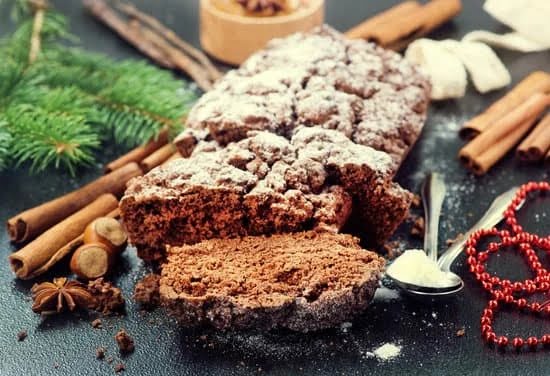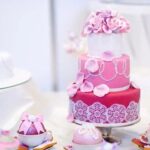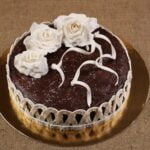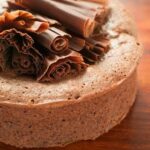The art of cake decoration has long captivated and delighted both amateur bakers and professional pastry chefs alike. The intricate designs and beautiful creations that can be achieved with icing have made it an essential skill in the world of baking. In this blog post, we will explore the enchanting realm of simple icing cake decoration, a technique that is accessible to beginners yet still capable of producing stunning results.
Simple icing cake decoration offers a wonderful starting point for those new to the craft. It allows beginners to develop their skills and creativity while working with basic tools and techniques. Whether you aspire to create elegant floral patterns or whimsical designs, simple icing techniques provide an exciting way to express your artistic flair on baked treats.
What sets simple icing cake decoration apart is its focus on achievable techniques that can be quickly mastered. While more intricate designs may require years of practice, simple icing techniques offer instant gratification, allowing beginners to see their progress right away.
Through this blog post, we aim to inspire and guide readers in exploring this delightful art form, providing insights into different types of icing, essential tools, step-by-step instructions, troubleshooting tips, decorating ideas, and photography tips for capturing those Instagram-worthy moments.
Whether you are planning to surprise loved ones with a beautifully decorated birthday cake or looking to develop a new hobby that brings delight both in the process and final result, join us as we delve into the magical world of simple icing cake decoration. With our guidance and your creativity, there is no limit to what you can achieve. So grab your apron and let’s embark on this sweet adventure together.
Understanding the Basics
The section on “Understanding the Basics: Types of Icing for Cake Decoration” will provide readers with a comprehensive understanding of the different types of icing commonly used in cake decoration. By explaining the characteristics and ideal uses for each type of icing, this section aims to help beginners choose the right icing for their simple decoration projects.
Buttercream and royal icing are two commonly used types of icing in cake decoration.
Buttercream is a smooth and creamy icing that is easy to work with and perfect for beginners. It has a light and fluffy texture, making it ideal for creating decorative borders, flowers, and other intricate designs. Buttercream can be flavored or colored to suit various themes or tastes, allowing for versatility in design. Moreover, buttercream can be easily adjusted in consistency by adding more powdered sugar or liquid, enabling decorators to achieve different textures for their desired effects.
On the other hand, royal icing is a firm and glossy icing made from confectioners’ sugar and egg whites. It hardens when dried, making it suitable for creating decorations that require structure and stability such as piping elegant shapes, intricate lacework, or writing messages on cakes.
Royal icing dries to a smooth finish with a slight sheen, giving a polished look to any cake design. Additionally, royal icing can be tinted with food coloring to create vibrant shades or thinned out with water or lemon juice for flooding techniques.
| Type of Icing | Characteristics | Ideal Uses |
|---|---|---|
| Buttercream | Smooth texture; easily adjustable consistency; flavors and colors well | Decorative borders, flowers, intricate designs |
| Royal Icing | Firm and glossy; hardens when dried; can be tinted or thinned out | Piping shapes, lacework, writing messages on cakes |
Understanding the different types of icing is crucial for beginners to achieve their desired cake decoration results. By providing this knowledge and explaining the ideal uses for each type, readers will be equipped with the necessary information to confidently select the right icing for their simple decoration projects.
Essential Tools
For those looking to explore the art of simple icing cake decoration, having the essential tools is crucial. These tools not only make the process easier but also allow for greater creativity and precision in designing beautiful cakes. Whether you are a beginner or an experienced baker, having the right supplies on hand will ensure that your cake decorations turn out exactly as you envision them.
One of the most important tools for icing cake decoration is a piping bag. This tool allows you to control the flow of icing and create intricate designs with ease. There are different types of piping bags available, such as disposable plastic ones or reusable cloth ones. Choose one that suits your preference and budget.
Another essential tool is a set of spatulas. These come in various sizes and shapes, each serving a specific purpose in cake decoration. A small offset spatula is great for spreading and smoothing icing on cakes, while a straight spatula can be used for scraping excess icing off surfaces. Having a variety of sizes will give you flexibility in creating different effects on your cakes.
Icing tips are also indispensable when it comes to simple icing cake decoration. These interchangeable tips attach to the end of piping bags and determine the design or texture of the icing. They come in different shapes, such as round, star, or petal-shaped tips, each yielding unique outcomes when used to decorate cakes.
| Piping Bag | Spatulas | Icing Tips |
|---|---|---|
| Allows for control over icing flow | Various shapes and sizes for spreading and smoothing icing | Determines design or texture of the icing |
| Disposable plastic or reusable cloth | Small offset spatula, straight spatula | Round, star, or petal-shaped |
| Choose based on preference and budget | Offers flexibility in creating different effects | Yields unique outcomes when used for decoration |
In addition to these tools, other supplies such as icing bags couplers (which allow for easy tip changes), cake turntables (to rotate the cake while decorating), and a small palette knife (for intricate details) can also be helpful. While it is tempting to invest in every gadget available, beginners can start with just the basics and gradually expand their collection as they gain more experience.
Remember, having the right tools is only half the battle – practice and patience are key to mastering simple icing cake decoration. So gather your supplies, get creative, and enjoy the process of transforming plain cakes into works of edible art.
Step-by-Step Guide
Decorating a cake with icing can be an enjoyable and rewarding experience, especially when you are armed with some easy-to-follow techniques. Whether you’re a beginner looking to impress your friends and family or an experienced baker seeking new ideas, these simple icing techniques will help you create eye-catching designs that are sure to delight.
To get started, here is a step-by-step guide to some popular icing techniques that beginners can easily master:
1. Smooth Buttercream: Smooth buttercream icing creates a flawless finish on cakes and serves as the base for many decorative designs. Start by spreading a thin layer of buttercream over the cooled cake using an offset spatula. To achieve a smooth surface, dip the spatula in hot water and gently glide it over the buttercream in long strokes, repeating until the desired texture is achieved.
2. Ruffles: Ruffles add elegance and texture to any cake design. Fill a piping bag fitted with a petal tip with your chosen colored buttercream or royal icing. Starting at the bottom edge of the cake, apply pressure to create small ruffled layers by moving the piping bag back and forth while moving upward along the side of the cake.
3. Royal Icing Dots: Create beautiful polka dot patterns using royal icing. Fill a piping bag fitted with a small round tip with royal icing and hold it perpendicular to the cake’s surface. Apply gentle pressure to pipe small rounds onto the cake in various colors or sizes, creating visually appealing arrangements.
Remember, practice makes perfect. Don’t be discouraged if your first attempts don’t turn out exactly as planned. Keep experimenting and refining your technique, and soon you’ll be creating stunning designs that will impress everyone who sees them.
By following this step-by-step guide and combining these simple icing techniques, you’ll be able to create eye-catching designs that will elevate your cake decorating skills. So grab your piping bags and get ready to unleash your creativity.
Adding Flair
When it comes to cake decoration, adding vibrant colors and delicious flavors to your icing can take your creations to the next level. In this section, we will explore various methods for incorporating colors and flavors into simple icing designs, allowing you to create visually stunning and delectable cakes.
- Colors: Adding vibrant colors to your icing can instantly elevate the visual appeal of your cake decorations. One popular method is using food coloring gels, which come in a wide range of shades and offer intense color payoff. It is advisable to start with a small amount of gel and gradually add more until you achieve the desired color.
- Natural Ingredients: Another way to infuse color into your icing is by using natural ingredients such as fruits or vegetables. For example, beetroot powder can be used to give a beautiful pink hue to buttercream icing, while spinach powder can create a natural green shade. Experimenting with natural colors not only adds visual interest but also allows you to incorporate healthier elements into your cake decorations.
Flavorful icings can transform an ordinary cake into a delightful taste experience. Here are some ideas for infusing different flavors into your simple icing designs:
- Extracts: Using extracts like vanilla or almond can add depth and enhance the overall flavor of your icing. Start by adding a small amount of extract and taste test before adding more, as these extracts tend to have strong flavors.
- Citrus Zest: Adding zest from citrus fruits like lemons or oranges can provide a refreshing burst of flavor in your icing. Be sure to carefully wash the fruit before zesting, as you want to avoid any bitterness from the pith.
- Spices: Spices such as cinnamon, ginger, or cardamom can bring warmth and complexity to your icing. Experiment with different combinations to find the perfect spice blend for your cake.
To enhance the overall appeal of your simple icing designs, consider combining colors and flavors creatively. For example, you can create a lemon-flavored icing with a light yellow color or infuse a classic vanilla buttercream with a hint of lavender and a soft purple hue. The possibilities are endless, so don’t be afraid to let your imagination run wild.
Remember that incorporating colors and flavors into your simple icing designs should be approached with experimentation and creativity. Start by trying out small batches and adjust according to your personal taste preferences. Don’t forget to document and share your creations on social media using relevant hashtags and tagging communities for feedback and inspiration.
By adding flair through colors and flavors, you will not only delight your taste buds but also impress others with visually stunning cake decorations that showcase your unique style and creativity.
Beyond the Basics
Enhancing with Sprinkles and Edible Flowers
To take your simple icing designs to the next level, consider incorporating additional decorations such as sprinkles and edible flowers. Sprinkles can add a pop of color and texture to your cake, creating a playful and festive look. Choose from a wide variety of sprinkle shapes, sizes, and colors to match the theme or occasion of your cake. You can opt for traditional rainbow sprinkles, metallic dragees for an elegant touch, or even customized sprinkles for a personalized touch.
On the other hand, edible flowers can bring a sense of beauty and sophistication to your simple icing designs. From delicate pansies to vibrant marigolds, there are numerous edible flower options that can elevate the visual appeal of your cake. Ensure that the flowers you choose are safe for consumption and have not been treated with any harmful chemicals. Gently place them on your icing design just before serving to maintain their freshness.
Dazzling Drizzles and Mirror Glazes
For those looking to create stunning visual effects on their cakes, drizzles and mirror glazes are excellent options. Drizzles involve pouring a thin stream of sauce or melted chocolate over the cake in an artistic pattern. This technique adds depth and dimension to your design while also creating an enticing contrast between the smooth icing surface and the glossy drips.
Mirror glazes, on the other hand, create a mesmerizing mirror-like finish on top of your simple icing design. Made using ingredients like gelatin, condensed milk, sugar syrup, and food coloring, mirror glazes give cakes a show-stopping appearance that is sure to impress guests. The glaze is poured over chilled cakes covered in a layer of buttercream or ganache before setting into its characteristic flawless shine.
Combining Decorative Elements
One of the strengths of simple icing designs is their versatility and adaptability to various decorative elements. To truly create a masterpiece, consider combining different types of decorations to achieve a unique and visually arresting effect. For example, you can use sprinkles as a border around an intricate icing pattern or incorporate edible flowers into the design by delicately placing them on top of piped flowers.
Experiment with different combinations and placements to find what works best for your cake design. Have fun exploring the possibilities and don’t be afraid to think outside the box. Remember, the goal is to create a visually stunning cake that reflects your own personal style and creativity.
By incorporating additional decorations like sprinkles, edible flowers, drizzles, and mirror glazes into your simple icing designs, you can take your cakes from basic to extraordinary. These decorations add depth, texture, and creativity to your designs, allowing you to showcase your artistic flair. With endless options for combining different elements, the possibilities are truly limitless when it comes to elevating simple icing designs with additional decorations.
Troubleshooting
Uneven Icing
One common challenge that beginners may encounter when doing simple icing cake decoration is achieving a smooth and even layer of icing on the cake. Uneven icing can create a less polished and professional-looking finish. To address this issue, make sure to properly prepare your cake before applying the icing. Level the top surface of the cake using a serrated knife or a cake leveler to ensure an even base.
If you still find that your icing is uneven, try using an offset spatula to spread the icing in a gentle back and forth motion. This technique helps to distribute the icing evenly across the surface of the cake. You can also use a bench scraper or a straight-edged spatula to smoothen out any noticeable bumps or ridges in the icing.
Another tip for achieving even icing is to use thin layers of icing, allowing each layer to set before applying another. This method prevents excessive thickening and helps achieve a smoother finish. If necessary, you can place your cake in the refrigerator for a few minutes between each layer of icing to allow it to firm up slightly.
Collapsed Designs
Another common challenge that beginners may face when working with simple icing is dealing with collapsed designs. Collapsed designs occur when intricate or delicate decorations lose their shape or collapse under their own weight due to insufficient support from the underlying structure.
To prevent collapsed designs, it is crucial to properly support your decorations. If you are creating three-dimensional figures or structures using royal icing, consider adding support structures like toothpicks or small dowels inside them while they dry. This will provide stability and prevent them from collapsing.
For delicate decorations such as piped flowers or latticework, allow them ample time to dry before handling or transferring them onto the cake. A good practice is to create extra pieces as backups in case any break during transfer.
In addition, be mindful of the consistency of your icing. If it is too thin, it may not have enough stability to hold its shape. Adjust the consistency by adding more powdered sugar gradually until you reach a stiff yet pipeable texture.
Streaky or Runny Icing
Sometimes, beginners may struggle with streaky or runny icing, which can affect the overall appearance and design of their cake decoration. Streaks in icing are often caused by undermixing or unevenly incorporating food coloring or flavorings.
To avoid streaky icing, ensure that all your ingredients are properly mixed together before adding them to the base icing. Incorporate food coloring and flavorings gently but thoroughly, using a spatula or whisk to evenly distribute them throughout the icing.
If your icing becomes runny, it may mean that you added too much liquid. To remedy this, gradually add more powdered sugar to thicken the consistency until it is suitable for piping or spreading. Be cautious not to add too much at once as this can result in overly sweetened icing.
Remember, practice makes perfect. With time and experience, you will become familiar with troubleshooting common challenges in simple icing cake decoration and develop your own techniques for creating beautifully decorated cakes.
Showcasing Your Masterpiece
Photography plays a crucial role in showcasing the beauty and artistry of your simple icing cake decorations. Whether you want to capture your creations for personal memories or share them on social media platforms, knowing how to take stunning photos will enhance the visual impact of your cakes. In this section, we will provide you with some photography tips to help you present your simple icing cake decorations in the best possible light.
One important aspect of cake photography is lighting. Good lighting can make all the difference in highlighting the details and colors of your cake. Natural light, such as near a window, is ideal for capturing accurate colors and reducing harsh shadows. If natural light is not available or insufficient, using soft artificial lighting can also work well. Avoid direct overhead lighting, as it can create unflattering shadows on your cake.
Angles are another crucial element to consider when photographing your simple icing cake decorations. Experiment with different angles to find the one that showcases your design and texture most effectively. Often, shooting from a slightly above eye-level angle can provide a visually pleasing perspective while capturing all the intricate details on top of the cake.
Composition is also essential when photographing your cakes. Consider the arrangement and placement of props, such as plates, napkins, or flowers around the cake to create an appealing composition. Pay attention to background clutter and choose a clean backdrop that doesn’t distract from your decoration.
Finally, don’t be afraid to edit your photos after taking them. Simple adjustments like cropping, increasing brightness or saturation can help enhance the overall look of your images. However, be cautious not to over-edit as it may alter the true representation of your cake decoration.
By following these photography tips, you can elevate the presentation quality of your simple icing cake decorations and capture their beauty in stunning photographs. Remember that practice makes perfect, so keep experimenting with different techniques until you find what works best for you. Sharing your masterpiece online not only allows you to showcase your talent and creativity but also inspires others in their cake decoration journey.
Conclusion
In conclusion, simple icing cake decoration offers a world of possibilities for beginners and enthusiasts alike. Throughout this blog post, we have explored the basics of different types of icing, essential tools needed for simple decoration projects, step-by-step techniques for eye-catching designs, adding flair with colors and flavors, enhancing decorations with additional elements, troubleshooting common challenges, and showcasing your masterpieces through photography.
Through all these sections, one thing remains clear – the joy and satisfaction that comes from creating beautifully decorated cakes using simple icing techniques. Whether you are just starting out or looking to improve your skills, there is an excitement in learning new techniques and seeing your ideas come to life.
Cake decoration allows us to express our creativity and bring happiness to others through visually stunning edible art. So embrace the fun and adventure in experimenting with different designs and flavors. Don’t be discouraged by mistakes; they are opportunities to learn and grow. Share your creations with others on social media platforms, as it not only helps you gain feedback but also inspires others who are on their own cake decorating journey.
Remember that every cake you decorate is a reflection of your unique style and personality. So take the knowledge gained from this blog post, embrace the joy of simple icing cake decoration, and let your imagination run wild. The possibilities are endless.
Frequently Asked Questions
How to make a simple cake decoration?
Making a simple cake decoration can be a fun and creative way to add a personal touch to your baked goods. One easy option is to use edible decorations such as sprinkles or colored sugar. Simply apply a thin layer of frosting on your cake and gently press the decorations onto the frosting, ensuring they stick properly. Another idea is to use fresh fruits or flowers as a natural and vibrant cake topping.
Arrange sliced strawberries, raspberries, or blueberries on top of the cake for a burst of color and flavor. Additionally, you can also make simple designs using cookie cutters. Place the cookie cutter on the cake and lightly sift powdered sugar over it, creating an elegant pattern that will impress your guests.
How to decorate a cake with icing?
Decorating a cake with icing is a versatile technique that allows for endless creativity and customization options. To begin, ensure that your cake has cooled completely before applying the icing to prevent it from melting or running off. For basic icing decoration, you can use a buttercream frosting that is soft enough to spread but holds its shape well.
Start by covering the entire surface of the cake with a thin layer of icing known as the crumb coat, which helps seal in any loose crumbs and creates a smooth surface for the final layer of frosting. Once the crumb coat has set, you can proceed to decorate your cake by piping various shapes and patterns with different nozzles onto the surface using additional buttercream frosting.
What kind of icing is best for decorating cakes?
When it comes to choosing an icing for decorating cakes, different types offer distinct advantages depending on preference and desired outcome. Buttercream icing is one popular choice due to its creamy texture, versatility in flavors, and ability to hold intricate designs when piped onto cakes or cupcakes.
It is made by blending butter, confectioners’ sugar, vanilla extract, milk (or cream), resulting in a smooth consistency that is easy to work with while decorating cakes.

Welcome to our cake decorating blog! My name is Destiny Flores, and I am the proud owner of a cake decorating business named Cake Karma. Our mission is to provide delicious, beautiful cakes for all occasions. We specialize in creating custom cakes that are tailored specifically to each customer’s individual needs and tastes.





